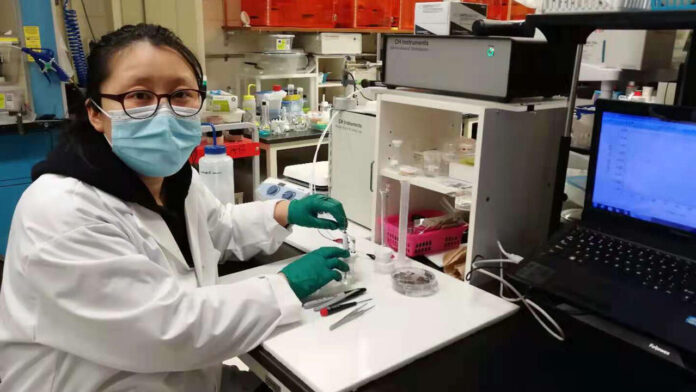Researchers at the University of Waterloo have developed a new, non-invasive method of testing blood sugar levels for diabetes patients.
Diabetes is caused by an inability to produce insulin, a vital hormone that helps to regulate the breakdown of essential sugars in the body. Current ways of monitoring blood sugar levels in the body are invasive and require finger-pricking to draw blood.
However, non-invasive methods of testing blood sugar may be possible in the future thanks to work by Wenyu Gao, a PhD student in UW professor Kam Tong Leung’s lab. Gao’s prototype is a sensor that combines nanomaterials and chemistry to detect sugar levels in saliva.
“A lot of the interesting work, including Wenyu’s saliva-based sensors, rely on fundamental chemistry occurring at the surface,” Leung said. “Two-dimensional materials like graphene are promising new nanotechnology materials that take advantage of this.”
Gao’s prototype consists of three layers of copper (Cu) nanomaterials anchored to a strip of graphene — a fairly unreactive and inexpensive carbon material.
The idea to use graphene as the base was proposed by Xiaojing Zhou, a visiting professor from the University of Newcastle, Australia.
“Graphene strips are thin and flexible just like paper, so you can deposit the materials on the top and it’s still flexible,” Gao said. “It’s a promising substrate in biosensors.”
The copper nanomaterials are layered on the graphene base as copper (Cu), copper I oxide (Cu2O) and copper II oxide (CuO). When glucose comes into contact with the copper I oxide layer, the copper atom gives up some of its electrons. This flow of electrons generates a small electrical current, which can be measured to determine the amount of glucose in a saliva sample.
Using nanomaterials in commercial healthcare not only introduces non-invasive options to patients, but also provides longevity to products available on the market. By eradicating the need for traditional enzymes, nanomaterials can provide a more lasting and durable option.
“Currently, commercial products are based on enzymes such as glucose oxidases, which limits the shelf life of these products to only a few months,” said Gao. “Enzymes are biological catalysts that are easily affected by the changing environment, causing them to lose their activity. We want to change these products to nanomaterials, which can last longer.”
In comparison to other enzymatic and non-enzymatic sensors available, the prototype developed by Gao detected a wider range of glucose levels and had higher sensitivity to small levels of glucose.
However, despite the potential benefits of glucose saliva sensors, there is still much work to be done before this method can be commercialized and replace traditional invasive methods of testing blood sugar content.
Currently, the prototype cannot test saliva directly since the reaction needs to occur in an environment with high (basic) pH. The pH of saliva is fairly neutral and requires the presence of a base like sodium hydroxide (NaOH) for the right reaction conditions. Additionally, glucose needs to be isolated from the saliva for an accurate determination of blood sugar levels.
However, the saliva glucose sensor prototype has shown promising results and Gao believes that:“We still have a long way to go, but I think that in the future we can still solve these problems step by step.”
































